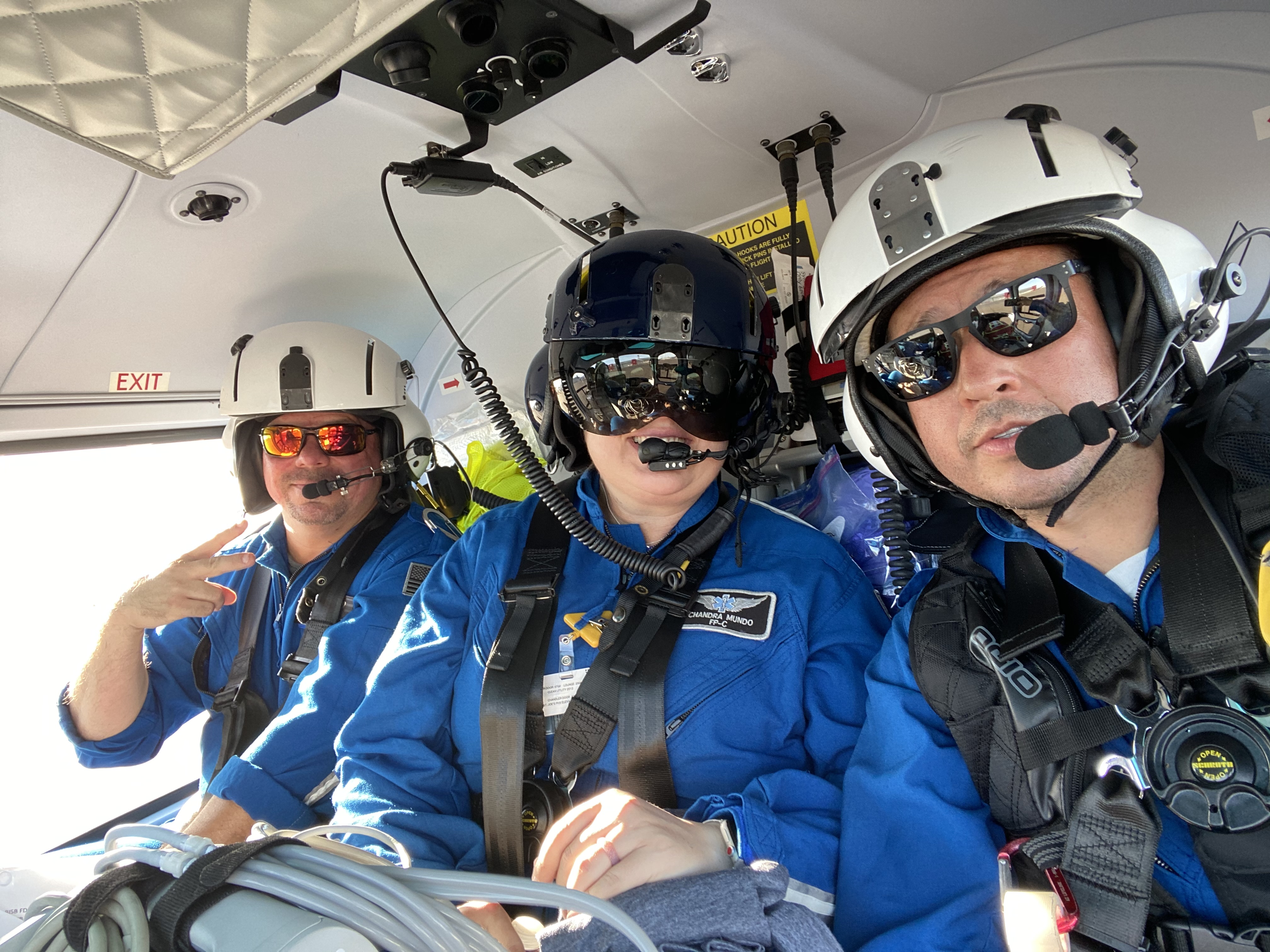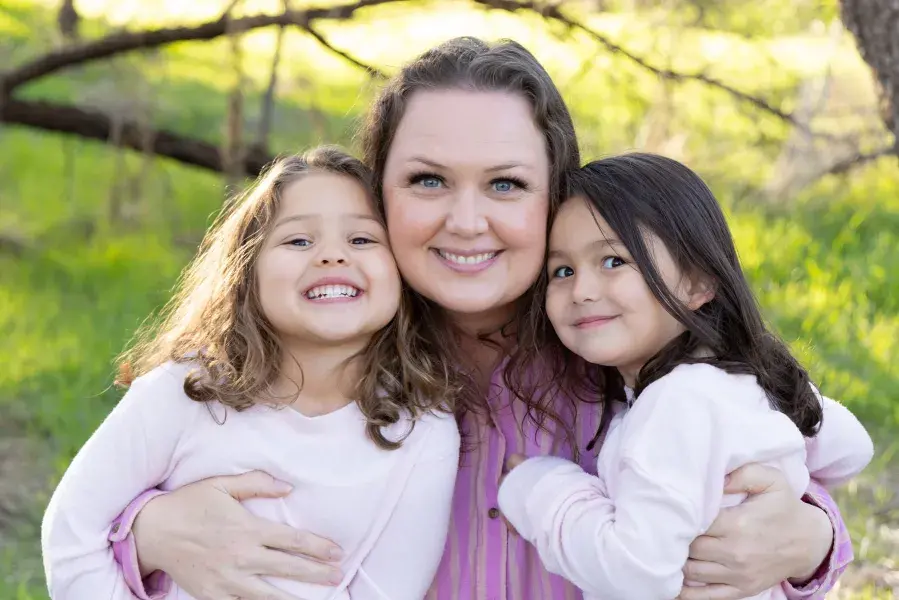Helicopter flight paramedic Chandra Fortune and her team had just completed a patient drop-off at the hospital.
As they headed back to base, the temperature hit a scorching 115 degrees, and the wind was pushing against them. They were halfway home when Chandra heard the pilot say, "Oh, shoot."
“Except he didn’t say ‘shoot,’” she laughs.
“That’s never a good thing when your pilot is up front cussing,” Chandra recalls.
She was right. They needed to land immediately. Chandra saw that the helicopter had just passed a cow pasture. If it turned around quickly, they could make an emergency landing there before hitting the mountainous terrain just ahead.
Of course, it wouldn’t be that easy. The pasture was surrounded by electric wires on all sides. If the blades were to hit one, they would have been done for. Thankfully, the pilot was able to land safely. But there were no road signs or indication of exactly where they were, so Chandra dropped a pin on her phone so her supervisor could find the crew.
“Our boss showed up and brought us some watermelon. It was the greatest thing ever,” she says.
That story, Chandra adds, is one she’ll think of whenever she hears the words “worst case scenario.” Challenges and obstacles are meant to be overcome, she feels, and like the old cliché says, what doesn’t kill you makes you stronger.
Maybe that’s why she’s never shied away from things that were difficult or scary. Not as a paramedic, not as a firefighter, not as a parent, and not as a student at the University of Arizona Global Campus.

Chandra (center) prepares to take off for another shift as a flight paramedic.
Turning Obstacles into Opportunities
After graduating college with a bachelor’s degree in fitness management, Chandra was unsure of what to do next, so she took an aptitude test to help her figure out what might be a good career fit.
“It said that I would be a good teacher and a firefighter,” said Chandra, “And I was like ‘Oh, I want to be a firefighter!”
So, she went right back to community college to get her emergency medical technician certification. She went through Fire Academy and became a volunteer firefighter – one of the 99,000 or 9% of women firefighters in the U.S. to do that job.
“I definitely had the odds stacked against me,” she says. “But I’m kind of a stubborn person and the more people told me that I couldn’t do it, the more I wanted to.”
Chandra says her stubbornness, and her determination, comes from her grandmother. It’s a trait, she adds, that pushes her to keep learning, keep growing, and keep taking on challenges.
“Being able to work as a firefighter really got me into the medical field because the majority of the calls that I went on were medical,” she recalls. “I would see the paramedics starting IV’s and reading EKGs, and I decided that was something I really wanted to do.”
Chandra moved to Tucson, Arizona, and took a job as an EMT for an ambulance company. Like her previous role, she needed training and went back to school to earn her paramedic provider license. She held that job for 13 years, spending the last seven as a flight paramedic.
Navigating the Winds of Change
A career as a flight paramedic can be harrowing, Chandra says. At her busiest, she was working 24-hour shifts, with three to four calls per day, each one lasting three to four hours. It was thrilling but exhausting. After some time, she had enough of 115-degree days in a flight suit and was rarely spending time at home. She was also pregnant with twins.
Chandra was ready for a change, but what that change should be was unclear. She says she was seeking something that would allow her to support her family financially and give her enough quality time to be with them.
Nursing seemed to be the solution. As a paramedic, Chandra had worked around nurses and saw the opportunities they had, so she decided that would be her next step.
“Once you have that nurse’s license, you just kind of follow your desires,” she says. “If you like working with infants you can be a NICU nurse, you can work with cancer patients as an oncology nurse.”
Chandra saw nursing as a way to turn something she enjoyed doing into more of a career, instead of a hobby, she explains.
Once again, she returned to school to become a registered nurse and completed her education in May 2021 while pregnant with twins. After, Chandra applied for two positions, one of which was in education.
Chandra knew the manager she would be working under for the education position and called her.
‘You’d make a great candidate, but you don’t have a bachelor’s degree,’ Chandra was told.
So, it was time to return to school – again.
Pushing Boundaries, Embracing Change
When faced with the idea that she wasn’t qualified for the position because she didn’t have a specific degree, UAGC became the solution she needed. The RN to BSN degree would allow her to provide the skills and background the company required for her to pursue that coveted education role in the future. In the meantime, attending college online allowed her to work in interventional radiology while taking classes and exams and caring for her twin girls.
It wasn’t easy, especially as a single mother.
“There were days where I would be on call and would think, ‘Oh my gosh! Can we hurry up; I need to go home. I need to write a five-page paper right now!’” she admits.
But even with all the struggles, Chandra has kept a great perspective that has helped her persevere.
“It’s really helped take it one day at a time and one task at a time, and just set some achievable goals,” she explains.
Chandra has always welcomed hard work but was happy to receive plenty of support from her aunt and her mom who lives with her and helps take care of the girls while she’s at work.
She also has the support of her employer, which granted her a scholarship to complete her BSN degree at UAGC.
A Career of Compassion
Chandra’s nursing classes at UAGC have opened her eyes to everything that was possible in the nursing field. Not just with a patient’s day-to-day care, but the health care sector as a whole, she says. Most people have an image of a nurse at bedside with a patient, she says, but in reality, the career is filled with opportunities to make an impact at every level.
Since enrolling in the RN to BSN program, Chandra has learned how to help patients utilize all the resources available to them, such as helping them find reliable transportation, so they don’t miss appointments. Her courses have taught her about being a good listener and using techniques to hone in on cues patients often give. She’s even learned how nurses can be lobbyists and affect health care laws.
With her BSN in sight, Chandra is working toward a future role in nursing education.
“That’s what I see myself aspiring to do,” she says.
Balancing Career and Family
Chandra is thankful her experience at UAGC has let her do what she loves and continue to keep moving forward.
“I really appreciate the opportunity to be able to obtain my bachelor’s degree and still be able to work full time,” she says. “That’s really meant a lot to me, and will definitely mean a lot to my career moving forward.”
Chandra can now continue to pursue her future career goals, while always making time for her family. At 4-years-old, her girls love to swim, just like mom who used to swim competitively and even worked as a lifeguard in her early career. They also go biking, horseback riding, play soccer, do gymnastics, and are in basketball camp, another sport in which Chandra excelled (she played for a nationally and state ranked team in high school).
“I try to share my love of sports with them and keep them busy,” Chandra adds.
--
Applicants to the Bachelor of Science in Nursing (RN-BSN) program at the University of Arizona Global Campus must have earned a nursing (hospital) diploma or Associate degree in Nursing from an approved accredited college or university including the following coursework or equivalent: Microbiology (with lab). Applicants must possess an active, unrestricted license to practice as a Registered Nurse or its equivalent in at least one U.S. state. All students must maintain this licensure throughout the program of study.
Certain degree programs may not be available in all states.
